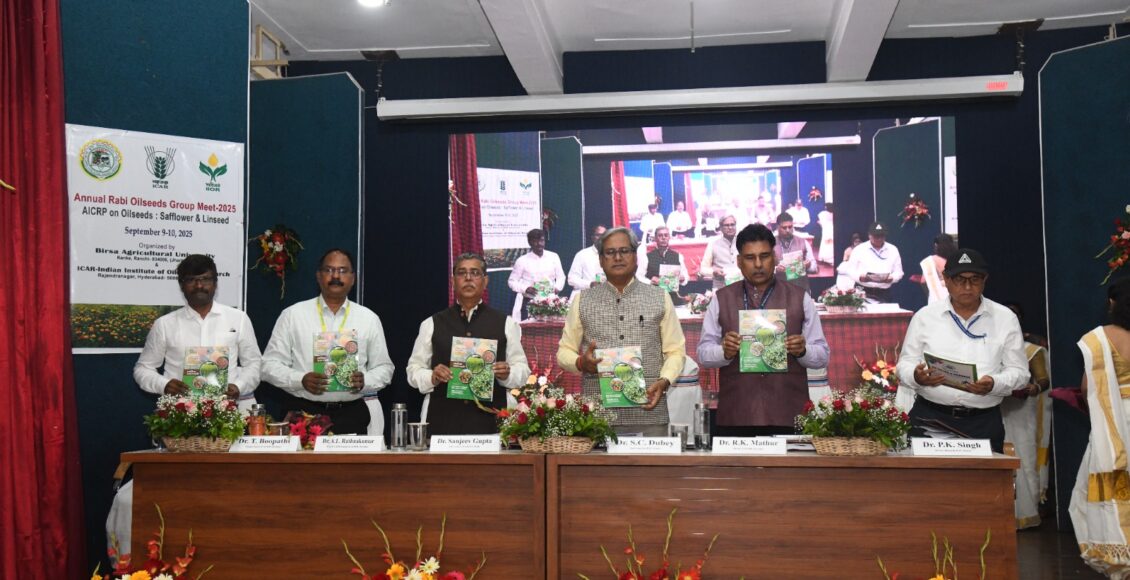Two-day Annual Rabi Oilseeds Group Meet begins at BAU
Jharkhand very potential state for oilseeds: Dr DK Yadava, DDG ICAR
Ranchi: Jharkhand is a very potential state for increasing the area, production and productivity of linseed as it is grown mostly in neglected areas by marginal and small farmers, said Dr DK Yadava Deputy Director General (Crop Science), ICAR.
He was addressing the two-day Annual Rabi Oilseeds Group Meet- 2025 organised at Birsa Agricultural University (BAU) on Tuesday. He said India has achieved self sufficiency in food grains, commercial crops and forage crops long back but still imports 55 percent of its edible oil requirement. Although per capita annual consumption of edible oils has increased from 4 kg in 1962 to 20 kg in 2024 but productivity is not increasing at desired pace.
Linseeds being used as seed for oil and fibre, faces strong competition from major rabi crops like wheat, chickpea and mustard for space and profitability. Farmers will not come forward for linseed despite its nutritional and medicinal value unless it is made more profitable by strong research programme leading to genetic improvement, the DDG added.
BAU Vice chancellor Dr SC Dubey said potential of linseed having anti oxidant and anti cancer properties and being part of ayurveda system since ancient times need to be properly harnessed. Limited availability of bio-fortified varieties, biotic and abiotic stresses, very low seed replacement rate and poor post harvest processing & value addition are major hurdles in its area expansion.
Dr Sanjeev Gupta, Additional Director General (Oilseeds & Pulses), ICAR said India has transformed from beggar of wheat to exporter of wheat during last 6 decades and similar dedicated endeavour is required on oilseeds front. During last one decade, area under linseed has decreased by nearly 20 percent.
We already have good scientists, institutions, global partnership and policy support for this sector and with integrated efforts will be able to increase area, productivity and oil content. A recently developed safflower variety has over 42 percent oil content although 94 percent area of this crop is concentrated to Karnataka and Maharashtra only.
Dr RK Mathur, Director, Indian Institute of Oilseeds Research (IIOR), Hyderabad outlined the achievements like varietal development, processing and value addition and seed production under the All India Coordinated Research Project on Safflower and Linseed during 2024-25.
BAU Director Research Dr PK Singh welcomed the gests while Dr Manigopa Chakraborty, Chairperson, Dept of Genetics & Plant Breeding proposed a vote of thanks.
Award for the best AICRP centre on Linseed went to Bihar Agricultural University, Bhagalpur and Indira Gandhi Gandhi Agricultural University, Raipur while Vasantrao Naik Marathwada Krishi Vidyapeeth, Parbhani, Maharashtra bagged the best centre award for safflower research.
Others who participated in the event included Dr AL Rathnakumar and Dr T Boopathi, Principal Scientists of IIOR, Hyderabad; Dr Abhijit Kar, Director, National Institute of Secondary Agriculture; Dr Sujay Rakshit, Director, Indian Institute of Agricultural Biotechnology; Dr Dr Vishal Nath, OSD, Indian Institute of Agricultural Research, Hazaribag; Dr NB Chowdary, Director, Central Tasar Research & Training Institute; Dr Awani Kumar Singh, Head, Farming System Research Centre for Hill and Plateau Region, Plandu, Ranchi; Dr SR Bhat, Former Principal Scientist, National Institute of Plant Biotechnology, New Delhi, Dr Anant Vishwkarma, Project Monitoring Committee Member and Dr BM Hegde, former Director, Indian Institute of Oilseeds Research, Hyderabad. Shashi Singh anchored the programme.

